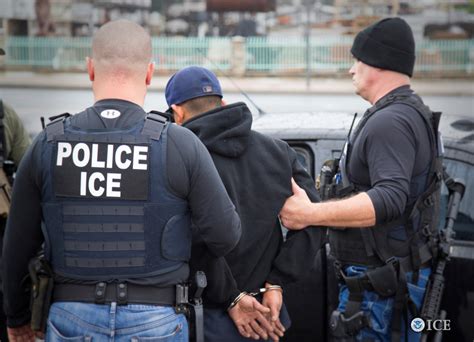
Two U.S. Immigration and Customs Enforcement (ICE) officers were inadvertently locked inside a shipping container along with deported migrants during an operation in Brownsville, Texas, last week. The officers were trapped for a “significant amount of time” and endured harsh conditions before being discovered and released, according to internal agency communications reviewed by Yahoo News.
The incident, described as a “serious security incident,” has raised concerns about safety protocols and operational oversights within ICE. The near-entrapment occurred during a routine operation to deport migrants to their home countries. While the exact duration of the officers’ confinement remains unclear, sources indicate they were inside the container long enough to experience distress due to the heat and lack of ventilation.
ICE has acknowledged the incident and stated that an internal review is underway to determine the circumstances that led to the officers being locked inside the container and to prevent similar occurrences in the future. The agency emphasized its commitment to the safety and well-being of its personnel.
The incident unfolded as ICE officers were overseeing the deportation process at a Brownsville facility. As part of the operation, migrants are typically transported in shipping containers to designated locations for processing and eventual repatriation. In this instance, the two officers entered a container, presumably to conduct checks or ensure the security of the individuals being deported. However, the container doors were subsequently closed and locked without the officers realizing they were still inside.
“This incident is being taken seriously, and a comprehensive review is being conducted to determine the facts and implement corrective actions,” an ICE spokesperson stated.
The immediate aftermath involved a frantic search when the officers were reported missing. Fellow ICE personnel initiated a search of the facility, eventually locating them inside the locked shipping container. Details regarding how the officers were finally freed have not been officially released, but sources suggest that colleagues had to force open the container doors.
The near-entrapment underscores the potential dangers inherent in deportation operations, which often involve complex logistics and the movement of large numbers of individuals. The incident highlights the need for rigorous adherence to safety protocols and the importance of ensuring clear communication among all personnel involved.
The incident has also triggered internal discussions about the adequacy of training provided to ICE officers regarding safety procedures and emergency response protocols. Some within the agency are calling for enhanced training to equip officers with the skills and knowledge necessary to prevent similar incidents from occurring in the future.
Furthermore, the incident has drawn attention to the working conditions faced by ICE officers, particularly in regions with extreme climates like South Texas. The combination of high temperatures and confined spaces can create hazardous environments, underscoring the need for adequate ventilation and temperature control measures in areas where migrants are temporarily held.
This is not the first time ICE has faced scrutiny regarding its operational practices. The agency has been the subject of numerous investigations and lawsuits alleging mistreatment of migrants and violations of due process. Critics argue that the incident involving the trapped officers is symptomatic of a broader culture of disregard for safety and accountability within the agency.
“This incident is deeply concerning and raises serious questions about ICE’s operational oversight,” said Clara Long, associate director at Human Rights Watch. “It underscores the need for greater transparency and accountability within the agency to ensure the safety and well-being of both migrants and ICE personnel.”
The incident comes at a time when the Biden administration is facing increasing pressure to address the ongoing situation at the U.S.-Mexico border. The administration has implemented a number of policy changes aimed at streamlining the deportation process and reducing the backlog of immigration cases. However, critics argue that these changes have not gone far enough to address the underlying problems plaguing the immigration system.
The incident involving the trapped ICE officers is likely to fuel further debate about the role and responsibilities of the agency. Proponents of stricter immigration enforcement argue that the incident highlights the dangers faced by ICE officers on a daily basis and the need for increased resources to support their work. Opponents, on the other hand, argue that the incident is a consequence of the agency’s overly aggressive enforcement tactics and the need for a more humane approach to immigration policy.
In the wake of the incident, ICE has pledged to review its operational procedures and implement corrective actions to prevent similar incidents from occurring in the future. The agency has also emphasized its commitment to providing its officers with the training and resources they need to perform their jobs safely and effectively.
However, it remains to be seen whether these measures will be sufficient to address the underlying problems that contributed to the incident. Critics argue that a more fundamental shift in the agency’s culture and priorities is needed to ensure the safety and well-being of both migrants and ICE personnel.
The investigation into the incident is ongoing, and further details are expected to emerge in the coming weeks. The findings of the investigation could have significant implications for ICE’s operational practices and its relationship with the communities it serves. The incident has undoubtedly shaken the agency and has raised questions about the effectiveness of its training programs and safety protocols.
The spotlight is now on ICE to demonstrate that it is taking the incident seriously and is committed to implementing meaningful reforms to prevent similar incidents from occurring in the future. The agency’s response will be closely watched by immigration advocates, policymakers, and the public.
The incident serves as a stark reminder of the human cost of immigration enforcement and the need for a more humane and effective approach to immigration policy. The focus must be on ensuring the safety and well-being of all individuals involved, including migrants, ICE personnel, and the communities they serve.
This incident occurred amidst a broader backdrop of heightened scrutiny surrounding ICE’s operations and practices. The agency has long been a target of criticism from human rights organizations and immigration advocates, who allege that its enforcement activities often result in the separation of families, the violation of due process rights, and the mistreatment of migrants. The recent incident involving the trapped ICE officers has only served to amplify these concerns and to renew calls for greater oversight and accountability within the agency.
The agency’s leadership faces a challenging task in addressing the issues raised by this incident and in restoring public trust in its operations. A thorough and transparent investigation is essential, as are concrete steps to improve training, enhance safety protocols, and promote a culture of respect for human rights. The future of ICE as an agency may well depend on its ability to demonstrate a genuine commitment to reform and to ensure that such incidents are never repeated.
The incident also sheds light on the difficult and often dangerous working conditions faced by ICE officers. While the agency’s enforcement activities are frequently criticized, it is important to recognize that ICE officers are often placed in challenging situations and are required to make difficult decisions under pressure. The incident involving the trapped officers serves as a reminder of the risks they face and the importance of providing them with the training, resources, and support they need to perform their jobs safely and effectively.
Ultimately, the incident involving the trapped ICE officers is a symptom of a larger problem: the lack of a comprehensive and humane immigration policy. The current system is broken, and it is failing to meet the needs of migrants, communities, and the country as a whole. A comprehensive solution is needed, one that addresses the root causes of migration, provides a pathway to citizenship for undocumented immigrants, and ensures that our borders are secure. Such a solution would not only be more just and humane, but it would also make our country safer and more prosperous.
The incident further fuels the debate regarding the treatment of migrants in detention facilities. Concerns have been raised repeatedly about the conditions within these facilities, including allegations of overcrowding, inadequate medical care, and unsanitary living conditions. The close proximity of ICE officers to these conditions, as highlighted by the shipping container incident, underscores the need for reforms to ensure the health and safety of everyone involved.
The need for independent oversight of ICE operations has been a long-standing demand from advocacy groups. This incident only reinforces that demand. Independent monitors could help to ensure that ICE is adhering to its own policies and procedures, as well as to international human rights standards. Such oversight would increase transparency and accountability, which are essential for building public trust in the agency.
The investigation into the incident must also examine the role of contractors in ICE operations. Increasingly, ICE relies on private companies to provide a range of services, including transportation and detention. These contractors are often subject to less oversight than government agencies, which can lead to abuses. The investigation should determine whether any contractors were involved in the incident and, if so, whether they followed proper procedures.
The response to this incident will be a critical test for the Biden administration. The administration has pledged to reform the immigration system and to treat migrants with dignity and respect. The way it handles this incident will send a clear message about its commitment to these principles. The administration must ensure that a thorough and transparent investigation is conducted, that those responsible are held accountable, and that steps are taken to prevent similar incidents from occurring in the future.
The ramifications of this incident extend beyond the immediate safety concerns. It also raises questions about the broader impact of ICE’s enforcement activities on communities across the country. The agency’s raids and deportations can have a devastating effect on families, businesses, and local economies. A more humane and sensible approach to immigration enforcement is needed, one that takes into account the needs of all stakeholders.
The incident involving the trapped ICE officers serves as a microcosm of the challenges and complexities of the U.S. immigration system. It highlights the need for comprehensive reform, greater oversight, and a more humane approach to enforcement. The Biden administration has an opportunity to address these issues and to create a system that is fair, just, and effective. It remains to be seen whether it will seize that opportunity.
The long-term effects of this incident on the morale of ICE officers are also a concern. Such events can erode trust in the agency’s leadership and create a sense of unease among officers who are already working in a high-pressure environment. It is important for ICE to address these concerns and to provide officers with the support they need to perform their jobs effectively and safely.
The incident underscores the importance of regular risk assessments in ICE operations. These assessments should identify potential hazards and develop strategies to mitigate them. In this case, a risk assessment might have identified the possibility of officers being trapped in a shipping container and led to the implementation of procedures to prevent such an event from occurring.
The incident also highlights the need for better communication between ICE and other agencies involved in immigration enforcement. Often, multiple agencies are involved in the same operation, and a lack of communication can lead to misunderstandings and errors. Clear communication protocols are essential for ensuring the safety and effectiveness of these operations.
The response to this incident should also include a review of ICE’s training programs. These programs should ensure that officers are adequately trained in safety procedures, emergency response protocols, and human rights standards. The training should also emphasize the importance of communication and teamwork.
The incident involving the trapped ICE officers is a reminder of the human element of immigration enforcement. It is easy to get caught up in the statistics and the policy debates, but it is important to remember that these are real people whose lives are affected by these policies. A more humane and compassionate approach to immigration enforcement is needed, one that takes into account the needs and the dignity of all individuals involved.
The incident also raises questions about the accountability of individuals who are responsible for safety lapses. Were proper procedures followed in this case? If not, who should be held responsible? It is important to hold individuals accountable for their actions to ensure that such incidents are not repeated.
The incident involving the trapped ICE officers serves as a wake-up call. It is time for a serious conversation about the future of immigration enforcement in the United States. A comprehensive and humane approach is needed, one that addresses the root causes of migration, provides a pathway to citizenship for undocumented immigrants, and ensures that our borders are secure. This is not just a matter of policy; it is a matter of morality.
The incident further underscores the need for a comprehensive review of ICE’s operational policies and procedures, with a focus on identifying and addressing potential safety hazards. This review should involve input from a wide range of stakeholders, including ICE officers, immigration advocates, and experts in safety and security.
The incident also highlights the importance of fostering a culture of safety within ICE. This means encouraging officers to report potential hazards without fear of reprisal and providing them with the training and resources they need to perform their jobs safely.
The incident serves as a reminder that immigration enforcement is a complex and challenging task. It requires a high level of professionalism, training, and oversight. It also requires a commitment to human rights and the rule of law.
The incident involving the trapped ICE officers is a stark reminder of the need for comprehensive immigration reform. The current system is broken, and it is failing to meet the needs of migrants, communities, and the country as a whole. It is time for Congress to act and to pass legislation that will create a fair, just, and effective immigration system.
The incident’s potential impact on ongoing legal challenges against ICE is also noteworthy. Attorneys representing migrants may use this incident as further evidence of the agency’s operational deficiencies and potential disregard for safety.
The incident has also sparked renewed calls for body cameras to be worn by ICE officers during enforcement activities. Proponents argue that body cameras would increase transparency and accountability and could help to prevent abuses.
The ultimate lesson of the incident involving the trapped ICE officers is that a more humane and sensible approach to immigration enforcement is needed. This approach should prioritize the safety and well-being of all individuals involved, including migrants, ICE officers, and the communities they serve. It should also be based on respect for human rights and the rule of law.
Frequently Asked Questions (FAQ)
1. What exactly happened in the ICE shipping container incident?
Two ICE officers were inadvertently locked inside a shipping container along with deported migrants in Brownsville, Texas. The container doors were closed and locked without the officers realizing they were still inside, trapping them for an unspecified, but “significant,” amount of time. The exact circumstances of how they were freed remain unclear, but fellow officers initiated a search and eventually located and freed them.
2. How long were the ICE officers trapped in the shipping container?
While the exact duration remains unclear in the source material, the officers were reportedly inside the container for a “significant amount of time,” long enough to experience distress due to the heat and lack of ventilation. The Yahoo News article did not provide a precise time frame, but emphasized the adverse conditions the officers faced.
3. What is ICE doing in response to this incident?
ICE has acknowledged the incident and stated that an internal review is underway to determine the circumstances that led to the officers being locked inside the container. The agency is also emphasizing its commitment to the safety and well-being of its personnel and plans to implement corrective actions to prevent similar incidents from happening in the future. According to the Yahoo News article, an ICE spokesperson stated, “This incident is being taken seriously, and a comprehensive review is being conducted to determine the facts and implement corrective actions.”
4. What are the concerns being raised as a result of this incident?
The incident has raised concerns about safety protocols and operational oversights within ICE, as well as the potential dangers inherent in deportation operations. Critics argue that the incident is symptomatic of a broader culture of disregard for safety and accountability within the agency. There are also concerns about the adequacy of training provided to ICE officers and the working conditions they face, particularly in regions with extreme climates.
5. What impact could this incident have on ICE’s operations and policies?
The incident could lead to a review and revision of ICE’s operational policies and procedures, with a focus on improving safety protocols and ensuring better communication among personnel. It could also fuel further debate about the role and responsibilities of the agency and the need for a more humane approach to immigration policy. The findings of the internal review could have significant implications for ICE’s operational practices and its relationship with the communities it serves. The incident may also impact ongoing legal challenges against the agency.









